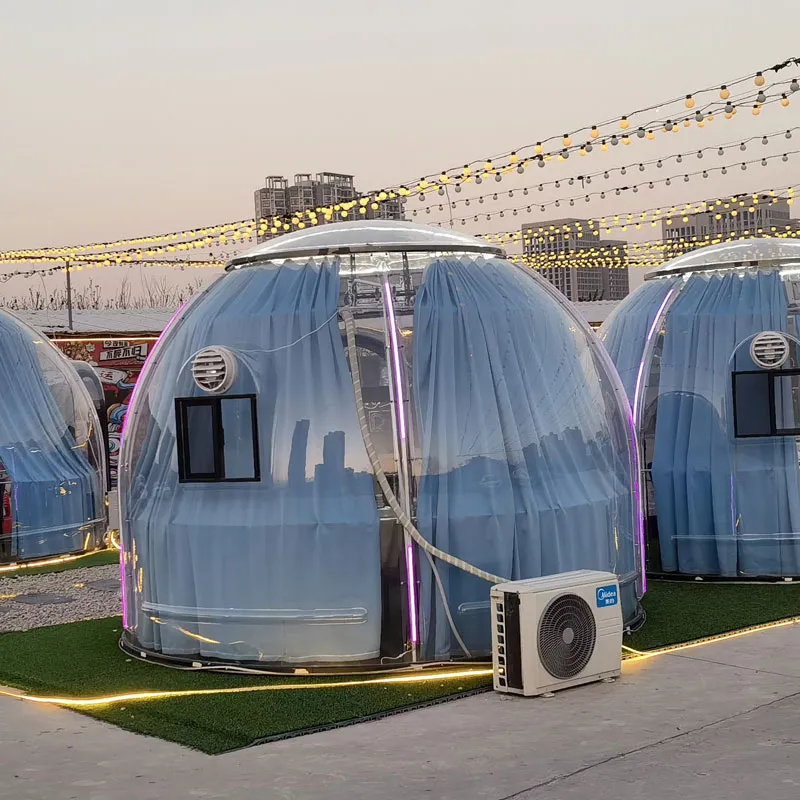What Are the Heating and Cooling Options for Bubble Houses?
2024-09-26

What Are the Common Heating and Cooling Options for Bubble Houses?
There are several heating and cooling options for Bubble Houses, such as air conditioning, heat pumps, solar thermal energy, and geothermal energy. Since Bubble Houses have a larger area exposed to sunlight, they can reduce heat loss while providing enough heat to maintain a comfortable temperature in winter. Additionally, some Bubble House owners have installed air conditioning or heat pumps, which are more traditional methods of conditioning indoor air temperatures.Can Bubble Houses Be Used in Extreme Weather?
Bubble Houses are suitable for many areas and are capable of providing a comfortable living environment. However, if you intend to use them in areas with extreme weather conditions, it is necessary to install additional thermal insulation materials and use the right heating methods to cope with the lower temperatures.Are There Any Safety Concerns About Living in Bubble Houses?
Bubble Houses are safe to live in and meet national building standards. They are made of strong polycarbonate materials that can withstand high-pressure situations, so there is no need to worry about safety when living in them. However, it is essential to ensure that the thermal insulation is sufficient to maintain a comfortable indoor temperature and avoid the formation of condensation which may affect the structural integrity of the Bubble House. In conclusion, Bubble Houses are a perfect blend of innovation and aesthetics that form unique and comfortable homes. They are becoming increasingly popular due to their uniqueness and energy-saving abilities. You can choose from different heating and cooling options to ensure a comfortable indoor temperature. If you want to build a Bubble House, you can contact Foshan Yuhoujiaoyang Building Materials Co., Ltd., who specialize in polycarbonate-based building materials. Our products are of high quality and affordable prices, and they are perfect for constructing Bubble Houses. For more details, please feel free to contact us at yuhoujiaoyang01@gmail.com.References
1. A. K. Athienitis and N. Wijeysundera (2003). Using transparent insulations in buildings: A review of heat transfer mechanisms and simulation models. Renewable and Sustainable Energy Reviews, 7(3), 223-243.
2. S. Sajjadi, K. Sopian, and N. A. Rahim (2015). An overview of solar energy assisted heating and cooling system for buildings. Renewable and Sustainable Energy Reviews, 42, 460-477.
3. K. Tokuç and M. Deniz (2019). An experimental study on thermal insulation properties of bubble insulation. Journal of Building Engineering, 23, 357-366.
4. A. A. Afshari, A. Varma, and A. T. Hodgson (2013). The indoor environment and occupants' activities in energy-efficient dwellings heated with air source heat pumps. Building and Environment, 70, 69-81.
5. T. R. Olofsson, R. Skjevrak, and K. E. Frydenlund (2012). Simulating the energy performance of an earth-source heat pump system for dwelling heating and domestic hot water production. Renewable Energy, 39(1), 51-60.
6. L. Xuan, D. Jing, and M. Yu (2018). Theoretical research and thermal performance analysis of polycarbonate light panel structure. Journal of Building Engineering, 18, 72-78.
7. M. K. Dubey, A. B. Pandey, and H. L. Tiwari (2014). Energy and economic analysis of solar-powered air conditioning system. Solar Energy, 101, 26-34.
8. B. V. Babu, M. S. Reddy, and V. K. Pandey (2013). An experimental study on geothermal heat pump assisted tail water recovery greenhouse heating system. Applied Thermal Engineering, 53(2), 121-129.
9. L. Han and W. Shi (2019). Research on the thermal insulation performance of geothermal HVAC pipe networks. Energy and Buildings, 190, 164-174.
10. L. Guo, M. Huang, and M. Yang (2017). Research on the insulation superiority and electrical performance of aluminum foil bubble film. Journal of Building Engineering, 14, 18-28.




















































